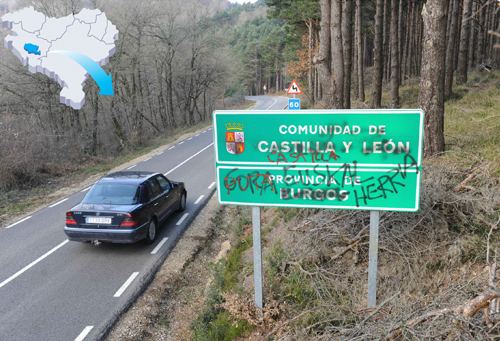Time zone CET (UTC+1) Enclave Enclave of Treviño Postal code 09215/09216/09217/09294 | Elevation 552 m (1,811 ft) Area 279.6 km² Population 1,961 (2009) | |
 | ||
The Treviño Enclave (Basque: Trebiñuko Barrendegia Spanish: Enclave de Treviño) in northern Spain is part of the territory of the province of Burgos (part of Castile and León), but is completely surrounded by the territory of the Basque Country province of Álava. Thus, it is an enclave of the Basque Country and an exclave of Castile and León. It consists of two municipalities—Condado de Treviño and La Puebla de Arganzón—and is part of the legal district (partido judicial) of Miranda de Ebro in the province of Burgos.
Contents
The enclave consists of the municipalities of Condado de Treviño, with an area of 260.71 square kilometres (100.66 sq mi) and a 2009 population of 1,432, giving it a population density of 5.49 per square kilometre (14.2/sq mi) and La Puebla de Arganzón, with an area of 18.87 square kilometres (7.29 sq mi) and a 2009 population of 529, giving it a population density of 28.03 per square kilometre (72.6/sq mi). This gives the enclave as a whole an area of 279.58 square kilometres (107.95 sq mi) and a 2009 population of 1,961, for a population density of 6.77 per square kilometre (17.5/sq mi).
History
La Puebla de Arganzón obtained its founding fueros from Sancho VI of Navarre ("Sancho el Sabio", "Sancho the Wise") in 1191. The original fuero of Condado de Treviño is lost, but is believed to have been granted by the same king in 1161. In 1200 it was conquered by Alfonso VIII of Castile.
After Castile conquered Álava, most of the region was left under the relatively egalitarian fueros typical of the Basque Country. Treviño was not. First a royal seigneury, Treviño de Uda and its outlying villages were granted in 1366 to the noble Manrique family. In 1453 Diego Gómez Manrique de Lara y Castilla became a count, hence the Condado [County] de Treviño. His son Pedro Manrique de Lara became Duke of Nájera in 1482, a title that continues in the family down to the present day. In the 16th century these Counts of Treviño, Dukes de Nájera since 1593, built a palace at Treviño, which is now the ayuntamiento (town hall) of the municipality.
As a result, Treviño remained closely tied to Castile. The enclave of Treviño was one of the few enclaves preserved in the 1833 territorial division of Spain, an island of Old Castile in the midst of Álava. That arrangement of the territory of Spain remains largely in effect today, although the province of Burgos is now part of Castile-León rather than the historic region of Old Castile.
Language
Many of the local place names in the enclave are of Basque language origin, especially in the central and eastern parts. The Basque language is supposed to have been spoken in the enclave up to the late 18th century. As late as 1810, a French civil servant, Eugène Coquebert de Montbret, pinpointed La Puebla as the southernmost Basque speaking town in Álava on a map showing Basque language boundaries.
There is no formal recognition of Basque (Basque: Euskara) (official in all of Alava and spoken in a few northern towns of that province, but not in Treviño or in most of Alava anymore until the revival of the language in the late 20th century) as a language of the autonomous community. According to El Diario, a local ikastola (Basque language school) has been created relying on young couples from Vitoria who have settled in the enclave. The main Basque education journal (Hik Hasi) claims an enrollment of children originating from the following locations: Tuyo, Grandival, Añastro, Burgeta, Pangua, Miranda, Araico, San Esteban, and Vitoria, all located in Treviño or surrounding areas. At any rate, local councils have agreed to promote Basque in their towns.
Current status of the enclave
The status of the enclave of Treviño has long been the subject of bitter contention between the autonomous government of Castile and León and the governments of the Basque Country, especially the provincial government of Álava. The impulse to integrate the enclave into Álava extends to nearly the whole political spectrum in Álava, such as the regional branch of the right-of-center PP, who differ with their co-partisans in Burgos on the matter. Inmaculada Ranedo of the PP, the mayor of Condado de Treviño, as of July 2008 leans toward at least cooperation with Álava, but has chosen to let the governments at higher levels sort out the issues of formal status.
The inhabitants of the enclave receive many of their services (health, education, etc.) in Vitoria-Gasteiz, but they pay tax to the Spanish central tax office, and not to the autonomous Basque one, at least since 1833 (new Spanish administrative distribution). During the last 100 years of litigation, the population in the enclave has inclined either by votes or demanded by local agencies towards the annexation of Treviño to Álava. In 1940, just after the start of the Franco regime, a plebiscite in the enclave, conducted by the Civil Government of Burgos, showed 98 percent support for the integration of Treviño into Álava. However, that was not acted upon, The last 1998 popular vote supported by majority the celebration of a referendum on the issue, but so far the regional council of Castile and León has repeatedly rejected local claims.
